The Carina Nebula is a vast region of bright and dark nebulosity located in the southern constellation Carina. It is also known as the Eta Carinae Nebula, the Grand Nebula, and the Great Carina Nebula. With an apparent magnitude of 1.0 and an apparent size of 120 arcminutes, the nebula is easily visible to the unaided eye on a clear night. It has the designation NGC 3372 in the New General Catalogue and is listed as Caldwell 92 in the Caldwell catalogue.
The Carina Nebula lies 8,500 light-years away. It is one of the largest diffuse nebulae known. It spans about 460 light-years in diameter. The nebula is more than six times more distant than the Orion Nebula (Messier 42) and nevertheless appears both brighter and larger than the more famous M42. The Orion Nebula is better known because it is visible from virtually any place on Earth, while the Carina Nebula appears in the far southern sky and is invisible to most northern observers. M42 spans 24 light-years and lies 1,344 light-years away.
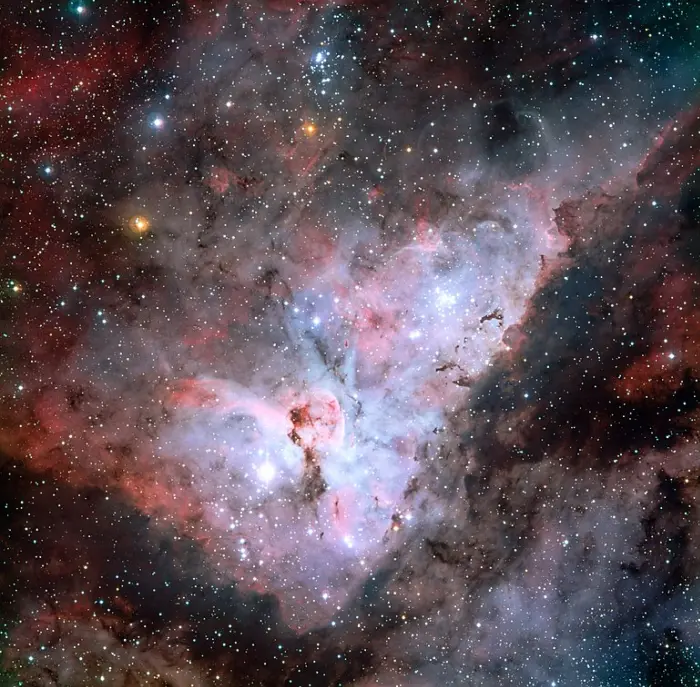
Colour-composite image of the Carina Nebula, revealing exquisite details in the stars and dust of the region. Several well known astronomical objects can be seen in this wide field image : to the bottom left of the image is one of the most impressive binary stars in the Universe, Eta Carinae, with the famous Keyhole Nebula just adjacent to the star. The collection of very bright, young stars above and to the right of Eta Carinae is the open star cluster Trumpler 14. A second open star cluster, Collinder 228 is also seen in the image, just below Eta Carinae. The Carina Nebula also bears the NGC 3372 designation. On this image, North is up and East is to the left. The field of view is 0.55 x 0.55 degrees, covering a 72 x 72 light-year region at the distance of the nebula. Image credit: ESO (CC BY 4.0)
NGC 3372 lies in the Carina-Sagittarius Arm of the Milky Way. It contains several young star clusters and smaller regions of nebulosity, including the Mystic Mountain, the Homunculus Nebula, and the Keyhole Nebula. The nebula is home to some of the most massive and luminous stars known, including the luminous blue variable Eta Carinae. X-ray images of the region reveal that NGC 3372 has also been a site of multiple supernova events.
In 2022, the Carina Nebula was one of the first deep sky objects imaged by NASA and ESA’s James Webb Space Telescope (JWST), along with Stephan’s Quintet in the constellation Pegasus, the Southern Ring Nebula (NGC 3132) in Vela, and the galaxy cluster SMACS 0723 in Volans.
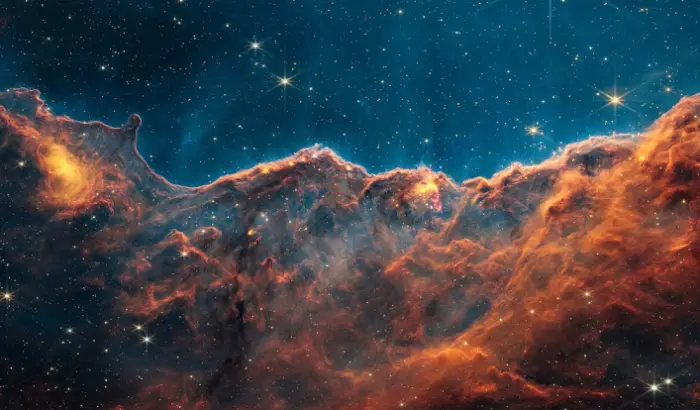
Scientists taking a “deep dive” into one of the iconic first images from the NASA/ESA/CSA James Webb Space Telescope have discovered dozens of energetic jets and outflows from young stars previously hidden by dust clouds. The discovery marks the beginning of a new era of investigating how stars like our Sun form, and how the radiation from nearby massive stars might affect the development of planets. Dozens of previously hidden jets and outflows from young stars are revealed in this new image from Webb’s Near-Infrared Camera (NIRCam). Image credit: NASA, ESA, CSA, and STScI, J. DePasquale (STScI)
Facts
The Carina Nebula was discovered by the French astronomer Nicolas Louis de Lacaille on January 25, 1752. Lacaille made two entries for the giant star-forming region in his catalogue, Lac III.5 and Lac III.6. He described Lac III.6 as a “Large group of a great number of small stars, little compressed, and filling out the space of a kind of a semi-circle of 15 to 20 minutes in diameter; with a slight nebulosity widespread in space.” The description of Lac III.5 matches the appearance of Collinder 228, one of the young open clusters of the Carina OB1 association.
Lacaille spent two years observing the southern constellations from the Cape of Good Hope in South Africa. During his stay, he observed almost 10,000 southern stars and created 14 new constellations. His observations were published in his southern catalogue Coelum Australe Stelliferum in 1763. Lacaille is credited for splitting the Greek constellation Argo Navis into three smaller constellations, Carina, Puppis, and Vela. Carina constellation represents the keel of the ship, Vela outlines the sails, and Puppis marks the stern.
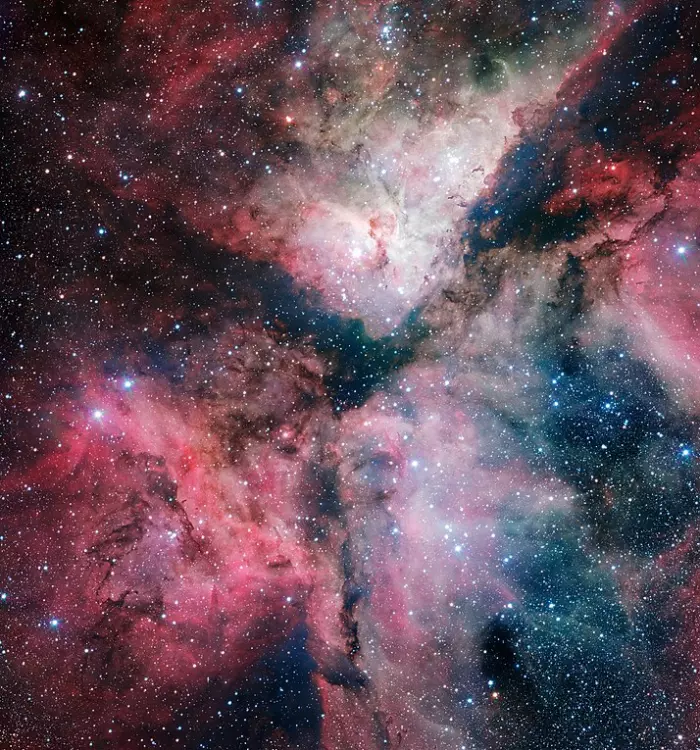
The spectacular star-forming Carina Nebula has been captured in great detail by the VLT Survey Telescope at ESO’s Paranal Observatory. This picture was taken with the help of Sebastián Piñera, President of Chile, during his visit to the observatory on 5 June 2012 and was released on the occasion of the new telescope’s inauguration in Naples on 6 December 2012. Image credit: ESO (CC BY 4.0)
The 19th century astronomers John Herschel and James Dunlop, who also travelled to the southern hemisphere to observe the southern skies, called the Carina Nebula the Eta Carinae Nebula or Eta Argus Nebula, referring to the former constellation Argo Navis. Argo Navis represented the ship on which Jason and the Argonauts sailed to Colchis to find the Golden Fleece. John Herschel described the nebula as “The star η Argus, with the Great nebula about it.”
The Carina Nebula is home to several exceptionally bright and massive stars, including Eta Carinae, WR 25, HD 93129A, and other multiple O-type stars. The stellar nursery is known to contain at least a dozen stars with a mass at least 50 to 100 times that of the Sun.
The first generation of newly formed stars in the nebula condensed about 3 million years ago, igniting in the middle of a large hydrogen cloud. Radiation from these young stars shaped a bubble of hot gas, which has kept expanding ever since. The stellar winds and ultraviolet radiation within the region are compressing cold hydrogen, resulting in more new stars being formed inside the nebula.
The pillars of dust and gas within the Eta Carinae Nebula will be destroyed by the young stars over the next 100,000 years. All that will remain is a bright open star cluster.
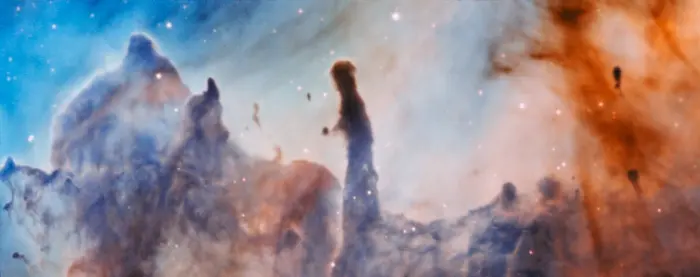
This image was taken by the MUSE instrument, mounted on ESO’s Very Large Telescope and shows the region R44 within the Carina Nebula. The massive stars within the star formation region slowly destroy the pillars of dust and gas from which they are born. Credit: ESO/A. McLeod (CC BY 4.0)
Hubble Space Telescope images
The Carina Nebula was captured by the Hubble Space Telescope (HST) on many occasions. The Hubble images showed various parts of the nebula, including the Homunculus Nebula, the Mystic Mountain, the Keyhole Nebula, and the region of the open cluster NGC 3324.
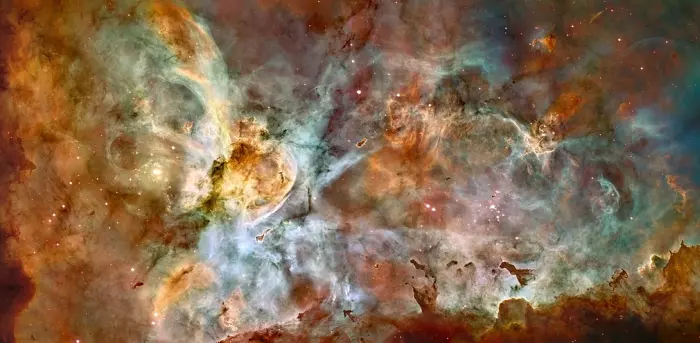
In celebration of the 17th anniversary of the launch and deployment of NASA’s Hubble Space Telescope, a team of astronomers released one of the largest panoramic images ever taken with Hubble’s cameras. It is a 50-light-year-wide view of the central region of the Carina Nebula where a maelstrom of star birth is taking place. This image is a mosaic of the Carina Nebula assembled from 48 frames taken with Hubble Space Telescope’s Advanced Camera for Surveys. The Hubble images were taken in the light of neutral hydrogen. Color information was added with data taken at the Cerro Tololo Inter-American Observatory in Chile. Red corresponds to sulfur, green to hydrogen, and blue to oxygen emission. Image credit: NASA, ESA, N. Smith (University of California, Berkeley), and The Hubble Heritage Team (STScI/AURA); credit for CTIO Image: N. Smith (University of California, Berkeley) and NOAO/AURA/NSF
The space telescope provided close-up views of the nebula’s complex gas structures, molecular clouds, Herbig-Haro objects, jets of gas ejected by young stars, and bow shocks produced when high-speed material collides with a slower-speed medium.
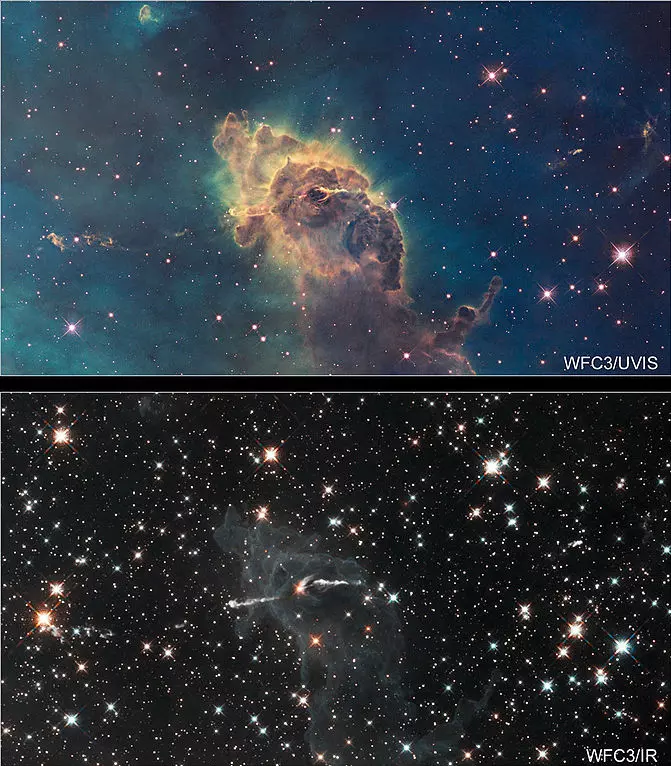
A huge pillar of star birth demonstrates how observations taken in visible and in infrared light by the NASA/ESA Hubble Space Telescope reveal dramatically different and complementary views of an object. Image credit: NASA, ESA and the Hubble SM4 ERO Team
James Webb Space Telescope image
In 2022, the Carina Nebula was one of the first targets of the James Webb Space Telescope (JWST). Webb peered through cosmic dust to reveal early star birth in a region nicknamed the Cosmic Cliffs, previously imaged by Hubble.
In July 2022, NASA and ESA released an image of the star-forming region NGC 3324, captured in infrared light by Webb’s Near-Infrared Camera (NIRCam). The image revealed regions of star formation that were previously hidden and provided astronomers with new insights into the period of early star formation.
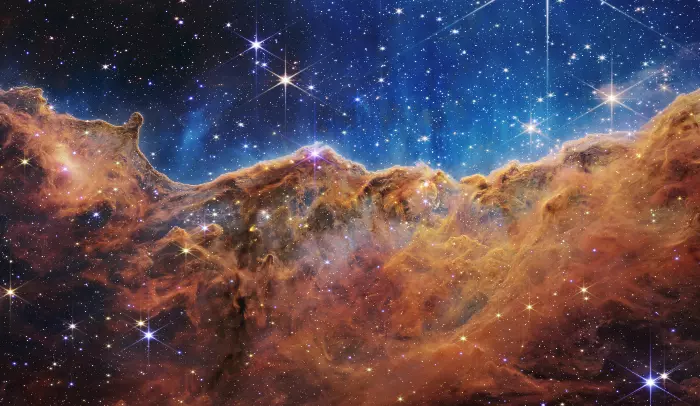
Behind the curtain of dust and gas in these “Cosmic Cliffs” are previously hidden baby stars, now uncovered by Webb. We know — this is a show-stopper. Webb’s new view gives us a rare peek into stars in their earliest, rapid stages of formation. For an individual star, this period only lasts about 50,000 to 100,000 years. Image credit: NASA, ESA, CSA, and STScI
The Cosmic Cliffs are found at the edge of a large cavity within NGC 3324. The cavity has been carved out by the intense ultraviolet radiation of exceptionally massive young stars formed in the vicinity. The high-energy radiation and strong stellar winds of these stars shape the nebula’s wall and gradually erode it away.
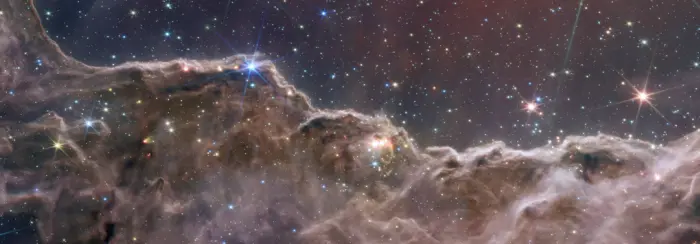
A composite image of the Cosmic Cliffs in the Carina Nebula, created with the Webb telescope’s NIRCam and MIRI instruments. Pinkish brown clouds of gas and dust dominate the foreground of the image, glittering with young stars. Behind the glowing, mountainous clouds, the sky appears navy blue, with shining stars and galaxies. Image credit: NASA, ESA, CSA, and STScI
Location
The Carina Nebula is located in the southern constellation Carina (the Keel). On a clear night, the nebula is easily visible to the unaided eye. It appears as a bright patch on the Milky Way’s band.
The Carina Nebula appears in the region of the sky dominated by three diamond-shaped asterisms: the Southern Cross, the Diamond Cross, and the False Cross. The Southern Cross is the brightest of the three, the False Cross is the largest, and the Diamond Cross is the least prominent and appears closest to the nebula.
A line drawn from Miaplacidus, the brightest star of the Diamond Cross and the second brightest star in Carina (after Canopus), through the midpoint of the imaginary line connecting Upsilon and Theta Carinae, leads to the nebula.
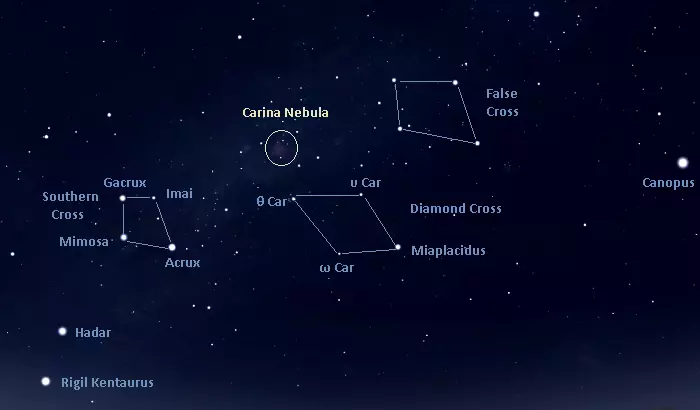
The location of the Carina Nebula (NGC 3372), image: Stellarium
Another way to find the nebula is to follow the imaginary line drawn from Rigil Kentaurus (Alpha Centauri) through Acrux (Alpha Crucis), the brightest star of the Southern Cross.
At declination 59°52’, the nebula is invisible to observers north of the latitude 30° N and it never rises very high above the horizon for northern observers in equatorial latitudes.
The best time of the year to observe the Carina Nebula and other deep sky objects in Carina is during the month of March, when the constellation is prominent in the evening sky.
Stars
The stars of the Carina Nebula are members of the Carina OB1 association, which is home to some of the Milky Way’s hottest, most massive and luminous stars and star clusters. Carina OB1 is one of the largest known stellar associations, spanning about 70 light-years (21 parsecs) across, and it is the most massive association in the Milky Way.
The young open clusters Trumpler 14 and Trumpler 16 are the main clusters within Carina OB1. The clusters NGC 3324, NGC 3293, Collinder 228, and Collinder 232 are also considered members.
The best-known stars in the Carina Nebula include the luminous hypergiant Eta Carinae, the Wolf-Rayet stars WR 22 (V429 Carinae) and WR 25, and the O-type star HD 93129. These stars form binary and triple star systems with massive companions and are members of the young open clusters embedded in the larger Carina Nebula.
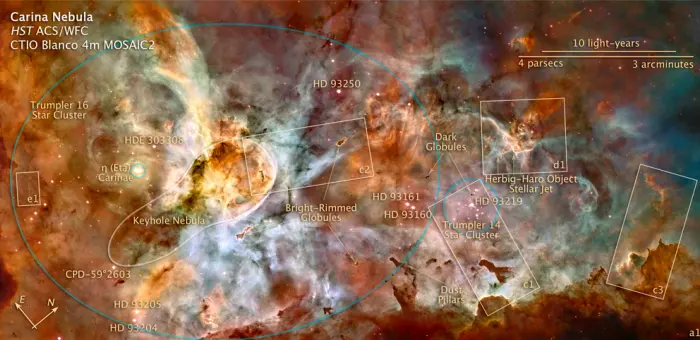
This labeled image identifies some of the significant features in the Carina Nebula region. The rectangles outline the details in the accompanying photographs. Several of the brightest stars are identified by their catalog numbers (CPD=Cape Observatory Photographic Durchmusterung, HD, HDE=Henry Draper Catalog), among the hottest, heaviest stars known. The brighter stars outside of the compact cluster Trumpler 14 belong to another larger cluster, Trumpler 16, which also includes the peculiar star Eta Carinae. Several of these are multiple systems: HD 93129 includes three stars. HD 93160 and HD 39161 are a binary system and HD 93161 is itself binary. Image credit: NASA, ESA, Z. Levay (STScI)
Eta Carinae
Eta Carinae is a massive star system composed of at least two hot, luminous stars located approximately 7,500 light-years away. The system shines at magnitude 4.3 – 4.8, but its brightness has been observed to vary from magnitude 7.6 to -1.0. Eta Carinae briefly became the second brightest star in the sky, after Sirius, during an episode known as the Great Eruption in 1843.
The primary component, Eta Carinae A, is a luminous blue variable (LBV) with 100 times the Sun’s mass and a radius about 240 times that of the Sun. Estimates of the star’s luminosity have been in the range from 2.96 to 4.6 million times that of the Sun.
Even though the star is less than 3 million years old, it has evolved quickly due to its high mass and will end its life soon (astronomically speaking) as a brilliant supernova. A core collapse supernova at this distance would peak at magnitude -4, comparable to that of Venus, while a superluminous supernova (SLSN) or hypernova may be five magnitudes brighter. The star system is too distant for the supernova to have any effect on Earth.
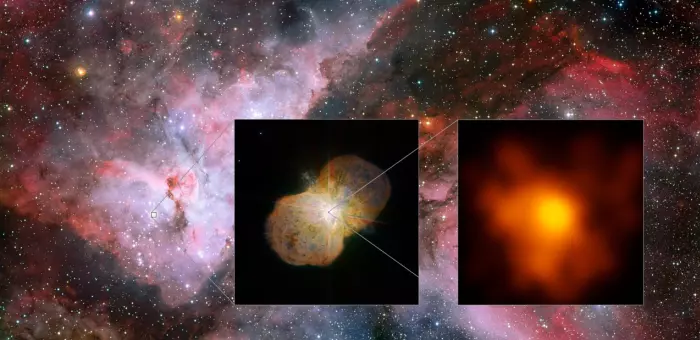
This mosaic shows the Carina Nebula (left part of the image), home of the Eta Carinae star system. This part was observed with the Wide Field Imager on the MPG/ESO 2.2-metre telescope at ESO’s La Silla Observatory. The middle part shows the direct surrounding of the star system: the Homunculus Nebula, created by the ejected material from the Eta Carinae system. This image was taken with the NACO near-infrared adaptive optics instrument on ESO’s Very Large Telescope. The right image shows the innermost part of the system as seen with the Very Large Telescope Interferometer (VLTI). It is the highest resolution image of Eta Carinae ever. Image credit: ESO/G. Weigelt (CC BY 4.0)
The companion, Eta Carinae B, has a mass between 30 and 80 solar masses and is also a supernova candidate. It is believed to be an O-type star or possibly a Wolf-Rayet star. The star has a radius between 14.3 and 23.6 times that of the Sun and is up to a million times more luminous than the Sun with an effective temperature of 37,200 K.
The Eta Carinae star system is embedded in the Homunculus Nebula, formed from material expelled during the Great Eruption episode. The nebula obscures the star at visual wavelengths.
Eta Carinae A has one of the highest mass loss rates known for any star. The stellar wind inside the nebula reaches speeds of 3,000 km/s and blows off a mass of 10−3 M☉ every year. Eta Carinae B is also losing mass, but its mass loss cannot be detected directly. It may be accreting mass from the primary component through an accretion disk.
The two stars have a highly eccentric orbit that takes them within 1.6 astronomical units (Earth-Sun distances) of each other and as far apart as 30 astronomical units. They have an orbital period of 5.54 years (2,022.7 ± 1.3 days). During their closest approach, the distance between the stars is comparable to that of the Sun and Mars, and when they are farthest apart, the distance is similar to that between the Sun and Neptune. At the closest point in their orbit, the stars’ stellar winds collide and there is a huge outflow of radiation and light.
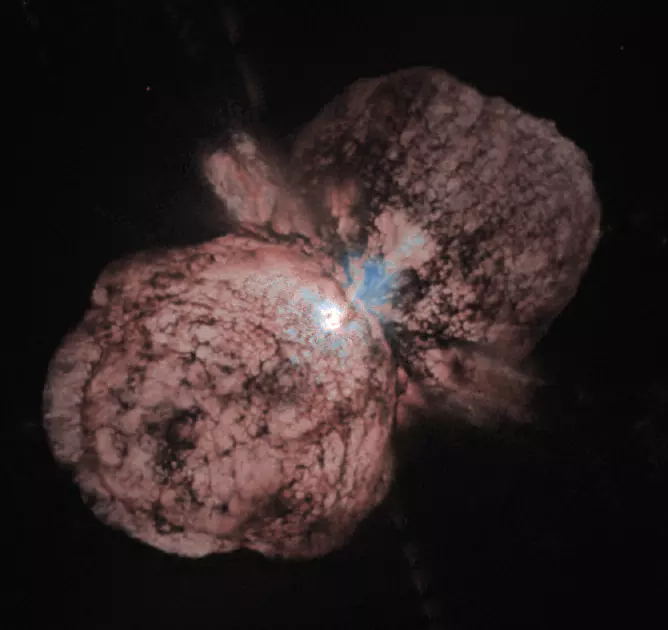
Eta Carinae was observed by Hubble in September 1995 with the Wide Field Planetary Camera 2 (WFPC2). Images taken through red and near-ultraviolet filters were subsequently combined to produce the color image shown. A sequence of eight exposures was necessary to cover the object’s huge dynamic range: the outer ejecta blobs are 100,000 times fainter than the brilliant central star. The observation shows that excess violet light escapes along the equatorial plane between the bipolar lobes. Apparently there is relatively little dusty debris between the lobes down by the star; most of the blue light is able to escape. The lobes, on the other hand, contain large amounts of dust which preferentially absorb blue light, causing the lobes to appear reddish. Image credit: Jon Morse (University of Colorado) & NASA Hubble Space Telescope
WR 22
WR 22 (V429 Carinae) is an eclipsing binary system located about 8,300 light-years from the solar system. The system consists of WR 22, one of the most massive and luminous stars in our galaxy, and an evolved O-type companion. The two stars have an orbital period of 80.336 days and eclipse each other as they orbit.
The primary component has a mass between 49 and 75 times that of the Sun and shines with 1,905,000 solar luminosities. The companion has 25.7 times the mass of the Sun and a luminosity 130,000 times the Sun’s.
The star system has an apparent magnitude of 6.42, which makes it theoretically visible to the unaided eye.
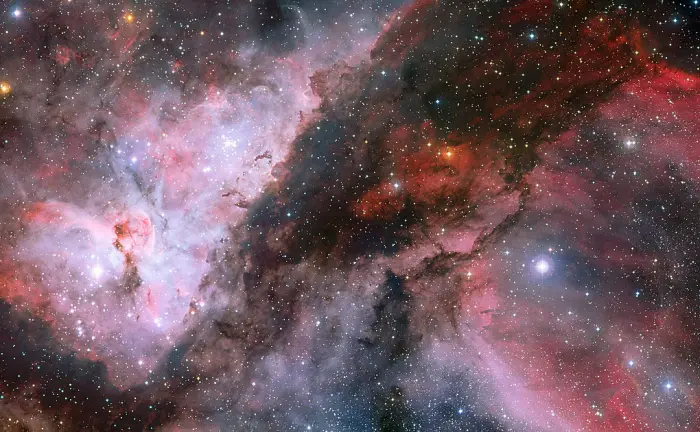
This spectacular panoramic view combines a new image of the field around the Wolf–Rayet star WR 22 in the Carina Nebula (right) with an earlier picture of the region around the unique star Eta Carinae in the heart of the nebula (left). The picture was created from images taken with the Wide Field Imager on the MPG/ESO 2.2-metre telescope at ESO’s La Silla Observatory in Chile. Image credit: ESO (CC BY 4.0)
WR 25
WR 25 is a massive binary star located approximately 6,425 light years away in the open cluster Trumpler 16. It is composed of an O-type supergiant and a Wolf-Rayet star in a 207.85-day orbit. The Wolf-Rayet star has 98 times the Sun’s mass and shines with 2,400,000 solar luminosities.
The star’s exceptional luminosity has an enormous effect on its environment, which is evident in the long filaments and arcs moving away from the system. These include the famous Finger of God nebula (Defiant Finger).
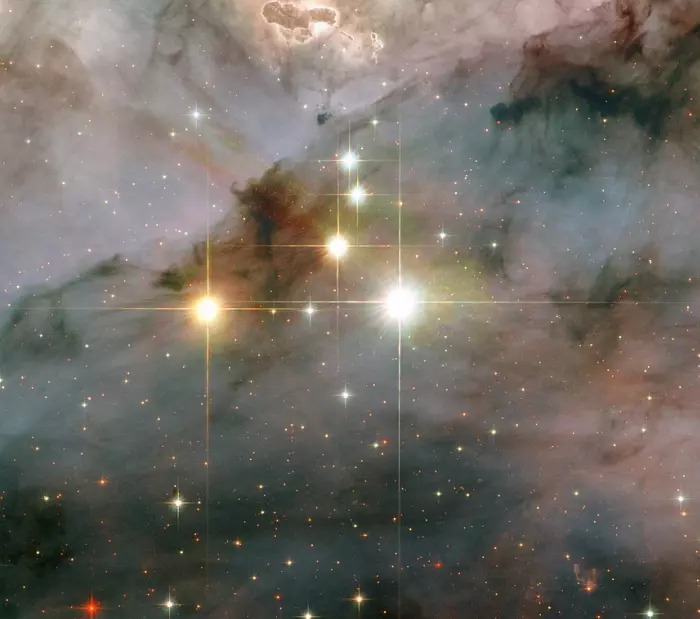
WR 25 (the bright star at the right), Tr16-244 (the star a bit to the left and higher), and Tr16-36 (the bright star to the left) located within the open cluster Trumpler 16. This cluster is embedded within the Carina Nebula, an immense cauldron of gas and dust that lies in the constellation of Carina, the Keel. Image credit: NASA, ESA and Jesús Maíz Apellániz (Instituto de Astrofísica de Andalucía, Spain)
HD 93129
HD 93129 is a triple star system located 7,500 light-years (2,300 parsecs) away. The system is the dominant member of the young open cluster Trumpler 14. With a combined apparent magnitude of 6.90, it is below the limit of unaided eye visibility.
HD 93129 is composed of three hot, luminous O-type stars that lie at the centre of Trumpler 14. The primary component is a hot blue supergiant of the spectral type O2If and the two companions are O-type main sequence stars.
The system consists of two visually resolved components, HD 93129 A and HD 93129 B, and HD 93129 A is itself a binary star. All three stars are exceptionally massive and luminous. HD 93129 Aa has a mass 110 times that of the Sun and a luminosity of 1,480,000 Suns. The star’s estimated age is about 0.9 million years.
The close companion, HD 93129 Ab, has a mass of 70 solar masses and shines with 575,000 solar luminosities. The more distant companion, HD 93129 B, is 52 times more massive than the Sun and also has a luminosity of 575,000 Suns.
HD 93250
HD 93250 is a close binary star with the stellar classification O4 IV(fc), indicating a hot blue subgiant. The properties of the individual stars are uncertain. As a single star, the system would have a surface temperature of about 46,000 K and a luminosity of a million Suns. The primary component has a mass about 49 times that of the Sun.
The two components have an orbital period of 194.31 ± 0.39 days and a semi-major axis of only 1.224 ± 0.028 milliarcseconds. The stars are separated by only 3.5 astronomical units. They were resolved using AMBER interferometry in 2010. The system has an estimated age of 1.3 million years.
HD 93250 appears about 7.5 arcminutes from Eta Carinae. It is a member of the open cluster Trumpler 16. It is the brightest source of X-ray emission in the Carina Nebula. The X-ray emission is believed to be caused by colliding stellar winds in the close binary system.
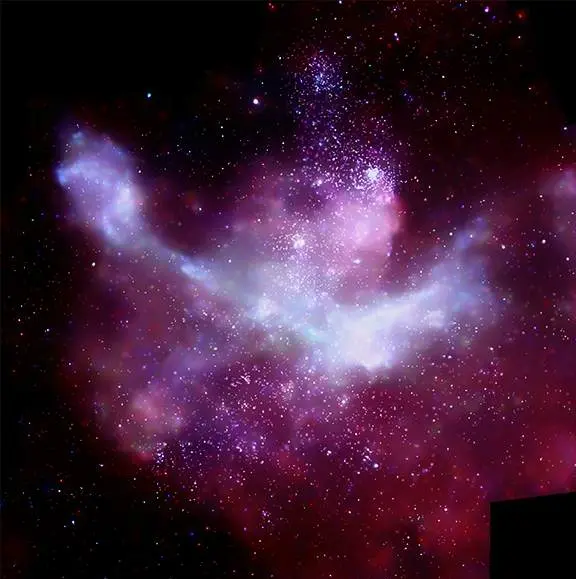
An image of the open clusters Trumpler 14, Trumpler 15 and Trumpler 16 in the Carina Nebula taken by the Chandra X-ray Observatory, image credit: NASA
HD 93205
HD 93205 (V560 Carinae) is a binary system composed of two massive O-type main sequence stars that orbit each other with a period of 6.0803 days. The system lies approximately 7,600 light-years away and appears 5 arcminutes from Eta Carinae. It has an apparent magnitude of 7.75 and is considered a member of Trumpler 16.
The primary component has a mass between 40 and 60 times that of the Sun and is 1,160,000 times more luminous than the Sun. The secondary star has more modest parameters: a mass between 17 and 25.3 solar masses and a luminosity of 112,000 Suns.
The star system is classified as a rotating ellipsoidal variable. Its brightness varies by 0.02 magnitudes with a period of about 6 days. Rotating ellipsoidal variables are close binary systems in which the components are so close that they are mutually deformed by gravity and have ellipsoidal shapes. The variations in brightness are caused by the changes in the amount of light emitting area that is visible. The variation period corresponds to the system’s orbital period.
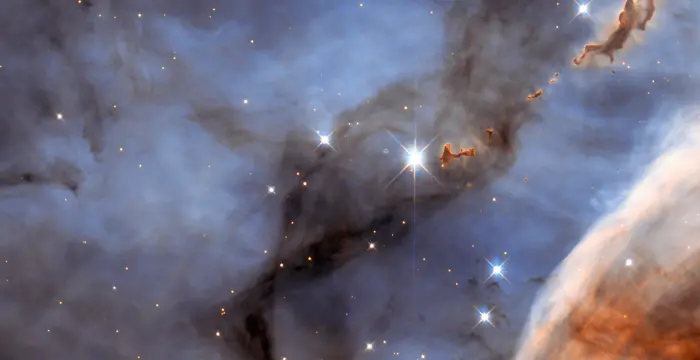
Looking like an elegant abstract art piece painted by talented hands, this picture is actually a NASA/ESA Hubble Space Telescope image of a small section of the Carina Nebula. The brightest stars in the image are not actually part of the Carina Nebula. They are much closer to us, essentially being the foreground to the Carina Nebula’s background. This picture was created from images taken with Hubble’s Wide Field Planetary Camera 2. Images through a blue filter (F450W) were coloured blue and images through a yellow/orange filter (F606W) were coloured red. The field of view is 2.4 by 1.3 arcminutes. Image credit: ESA/Hubble & NASA (CC BY 3.0)
Objects
The Carina Nebula is home to several smaller nebulae and young star clusters that host some of the most luminous stars known in the Milky Way galaxy. These include the Homunculus Nebula, which shrouds Eta Carinae, the pillar of dust and gas known as the Mystic Mountain, the dark Keyhole Nebula, and the clusters Trumpler 14 and Trumpler 16. Trumpler 14 is the youngest and most populated cluster in the group.
Homunculus Nebula
The Homunculus Nebula is a bipolar emission and reflection nebula within NGC 3372, directly surrounding the star Eta Carinae. The name of the nebula means Little Man in Latin.
The Homunculus Nebula is believed to have formed in the 1840s, when a powerful outburst briefly made the massive central star the second brightest star in the sky. The event is known as Nova Carinae 1843, or the Great Eruption.
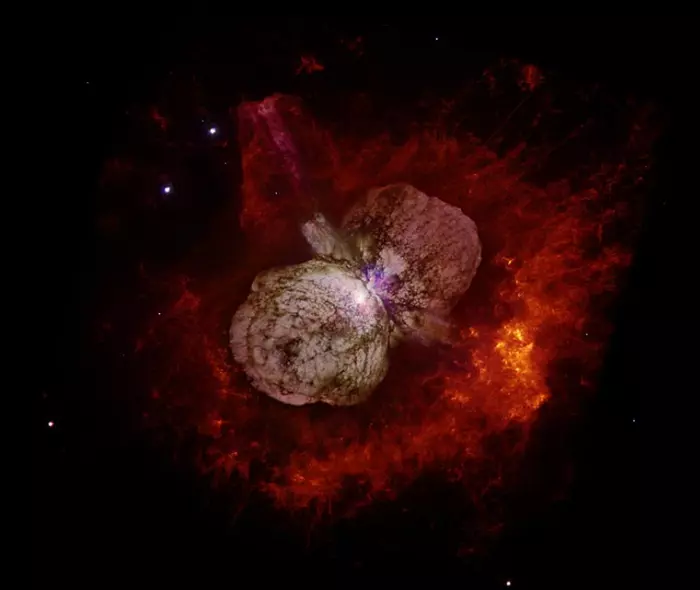
A huge, billowing pair of gas and dust clouds are captured in this stunning NASA Hubble Space Telescope image of the supermassive star Eta Carinae. Eta Carinae was observed by Hubble in September 1995 with the Wide Field and Planetary Camera 2 (WFPC2). Images taken through red and near-ultraviolet filters were subsequently combined to produce the color image shown. A sequence of eight exposures was necessary to cover the object’s huge dynamic range: the outer ejecta blobs are 100,000 times fainter than the brilliant central star. Eta Carinae suffered a giant outburst about 160 years ago, when it became one of the brightest stars in the southern sky. Though the star released as much visible light as a supernova, it survived the outburst. The event produced two lobes and a large, thin equatorial disk, all moving outward at about 1 million kilometers per hour. Image credit: Nathan Smith (University of California, Berkeley), and NASA
The outburst was also responsible for producing the nebula’s two lobes, as well as a large, thin disk, all expanding at an approximate speed of 1 million kilometres per hour.
The nebula has a radius of 0.29 light-years. It contains a smaller Little Homunculus which, in turn, contains Baby Homunculus, an inner shell of shocked material from the stellar winds of the massive stars.
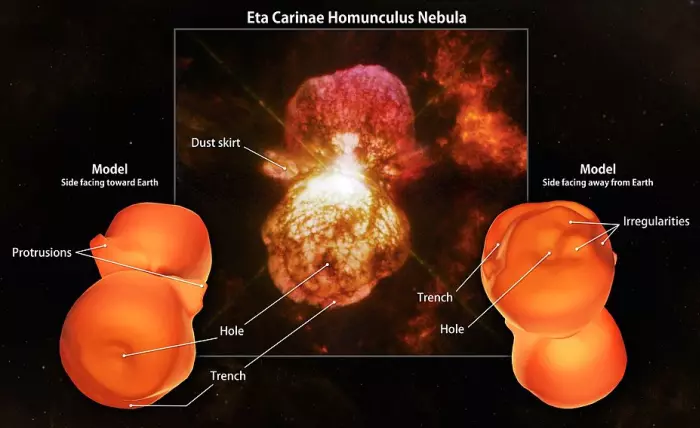
Between 1838 and 1845, Eta Carinae underwent the Great Eruption becoming the second brightest star in planet Earth’s night sky and ejecting the Homunculus Nebula. The new 3D model of the still expanding Homunculus was created by exploring the nebula with the European Southern Observatory’s VLT/X-Shooter. That instrument is capable of mapping the velocity of molecular hydrogen gas through the nebula’s dust at a fine resolution. It reveals trenches, divots and protrusions, even in the dust obscured regions that face away from Earth. Eta Carinae itself still undergoes dramatic outbursts, a candidate to end its life in a spectacular supernova in the next few million years. Image: NASA/GSFC/SVS; inset: NASA, ESA, Hubble SM4 ERO Team; science credit: W. Steffen (UNAM), M. Teodoro, T.I. Madura, J.H. Groh, T.R. Gull, A. Mehner, M.F. Corcoran, A. Damineli, K. Hamaguchi
Mystic Mountain
The Mystic Mountain is a pillar of gas and dust located inside the Carina Nebula. It was imaged by the Hubble Space Telescope (HST) in February 2010, on the 20th anniversary of the telescope’s launch. The images were taken with the Wide Field Camera 3. They showed a region with a shape resembling that of a mountain top surrounded by clouds.
The Mystic Mountain region is 3 light years or 190,000 astronomical units (AU) in height and contains nascent stars which fire off jets of gas that can be seen trailing from the mountain peaks. The young stars are embedded in Herbig-Haro objects, smaller bright patches of nebulosity that consist mostly of hydrogen and helium. The gas pillar is being slowly eroded by the light of the enormously large, massive young stars located above the pillar.
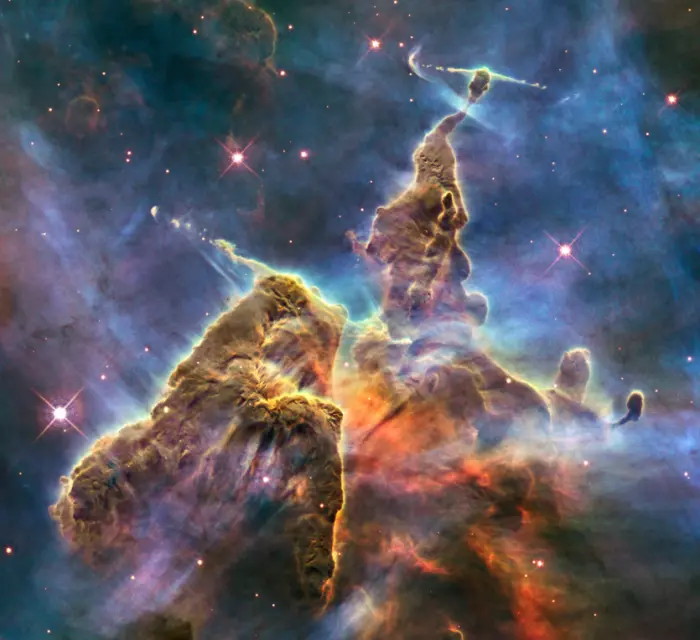
This NASA/ESA Hubble Space Telescope image of the Mystic Mountain captures the chaotic activity atop a pillar of gas and dust, three light-years tall, which is being eaten away by the brilliant light from nearby bright stars. Scorching radiation and fast winds (streams of charged particles) from super-hot newborn stars in the nebula are shaping and compressing the pillar, causing new stars to form within it. Streamers of hot ionised gas can be seen flowing off the ridges of the structure, and wispy veils of gas and dust, illuminated by starlight, float around its towering peaks. The denser parts of the pillar are resisting being eroded by radiation. Nestled inside this dense mountain are fledgling stars. Long streamers of gas can be seen streaking in opposite directions from the pedestal at the top of the image. Another pair of jets is visible at another peak near the centre of the image. These jets, known as HH 901 and HH 902, respectively, are signposts for new star birth and are launched by swirling gas and dust discs around the young stars, which allow material to slowly accrete onto the stellar surfaces. Hubble’s Wide Field Camera 3 observed the pillar on 1-2 February 2010. The colours in this composite image correspond to the glow of oxygen (blue), hydrogen and nitrogen (green), and sulphur (red). Image credit: NASA, ESA, and M. Livio and the Hubble 20th Anniversary Team (STScI)
Keyhole Nebula
The Keyhole Nebula is a small dark nebula about 7 light years in diameter. It was named for its keyhole shape, for which it is known. The Keyhole appears silhouetted against the bright Carina Nebula in the background. The appearance of the Keyhole has changed since the nebula was first discovered, likely because of changes in the central star’s ionizing radiation.
English mathematician and astronomer John Herschel observed the nebula from the Cape of Good Hope in the 1830s and described it as a “lemniscate-oval vacuity.”
The name Keyhole Nebula is attributed to the 19th century astronomy writer Emma Converse, who described the nebula’s shape as “resembling a keyhole” in an article published in Appleton’s Journal in 1873.
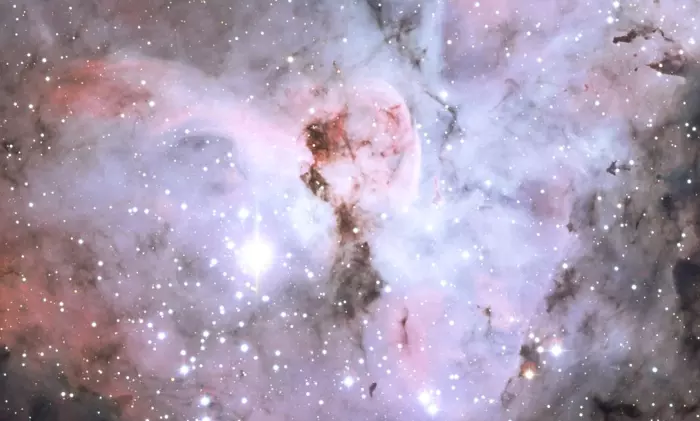
Colour-composite image of the Keyhole, a dark nebula within the Carina Nebula. Image credit: ESO (CC BY 4.0)
Finger of God
The Finger of God (or Defiant Finger) is a small Bok globule within the Keyhole Nebula. It was famously captured by the Hubble Space Telescope and its appearance in the Hubble image gave rise to its popular nicknames.
The Bok globule has a mass of at least 6 solar masses. It is believed to be ionized by the massive Wolf-Rayet star WR 25 and/or possibly by the blue supergiant Trumpler 16-244. It is likely a place where new stars are being born. The intense radiation of the nearby stars will gradually erode the cloud until it completely evaporates within 200,000 to 1,000,000 years.
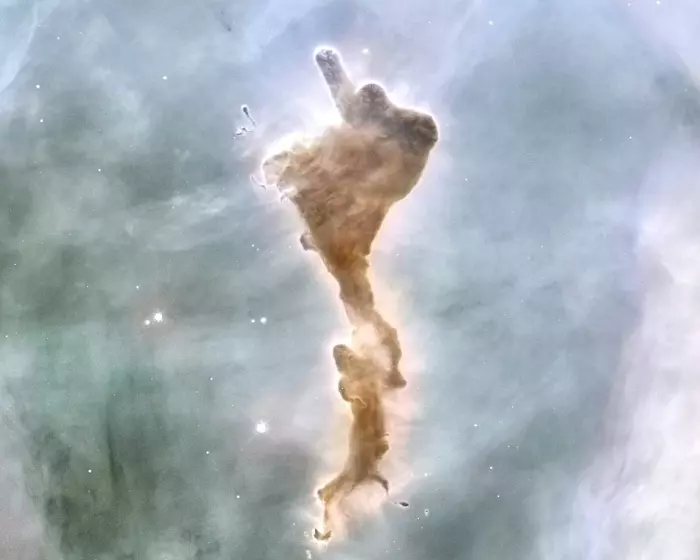
Informally named the “Finger of God” because of its suggestive shape, this 2 light-year long dark nebula is located within the Carina Nebula. Image credit: NASA, ESA, N. Smith (University of California, Berkeley), and The Hubble Heritage Team (STScI/AURA); credit for CTIO Image: N. Smith (University of California, Berkeley) and NOAO/AURA/NSF
Open clusters
The Carina Nebula contains at least eight open star clusters: Bochum 10, Bochum 11, Collinder 228, Collinder 232, Collinder 24, Trumpler 14, Trumpler 15, and Trumpler 16. The stars in these clusters are members of the Carina OB1 association. Several other clusters appear in this region of the sky and are also members of Carina OB1: NGC 3324, NGC 3293, and IC 2581.
Trumpler 14
Trumpler 14 (Tr 14) is an open cluster about 6 light-years across, located in the inner regions of the larger Carina Nebula. The cluster lies 8,980 light-years away. It has the designation Collinder 230 in Swedish astronomer Per Collinder’s 1931 catalogue of open clusters.
Trumpler 14 contains 2,000 known stars. It has an estimated mass of 4,300 solar masses and an estimated age between 300,000 and 500,000 years. It is one of the youngest open clusters known.
The brightest member in Tr 14 is the triple star system HD 93129, composed of three massive, luminous O-type stars. The cluster also hosts the exceptionally hot main sequence star HD 93128. All the bright members of the cluster have masses several tens of times that of the Sun.
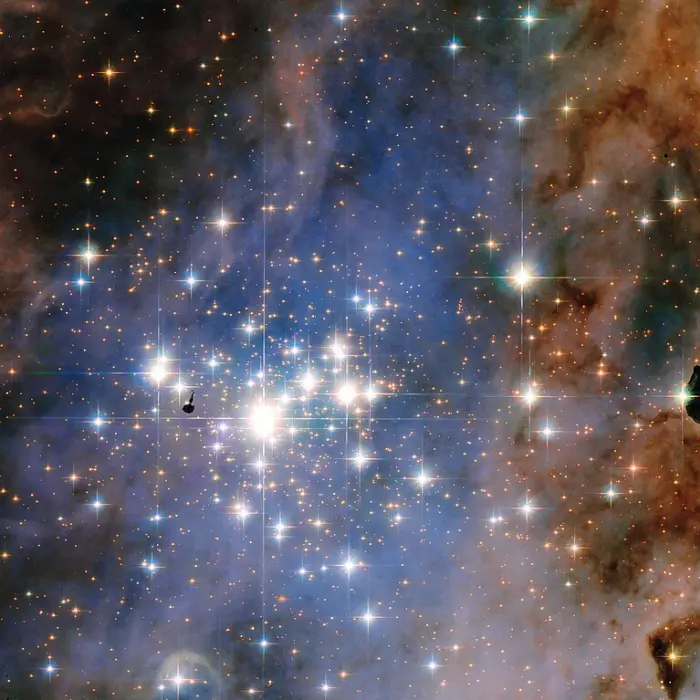
This NASA/ESA Hubble Space Telescope image features the star cluster Trumpler 14. One of the largest gatherings of hot, massive and bright stars in the Milky Way, this cluster houses some of the most luminous stars in our entire galaxy. Image credit: NASA & ESA, Jesús Maíz Apellániz (Centro de Astrobiología, CSIC-INTA, Spain)
Trumpler 15
Trumpler 15 (Tr 15) is an open cluster located approximately 8,600 light-years away. It has an apparent magnitude of 7.0. The cluster appears at the outer edge of the Carina Nebula. It is also catalogued as Collinder 231. It is slightly older than its neighbours Trumpler 14 and Trumpler 16.
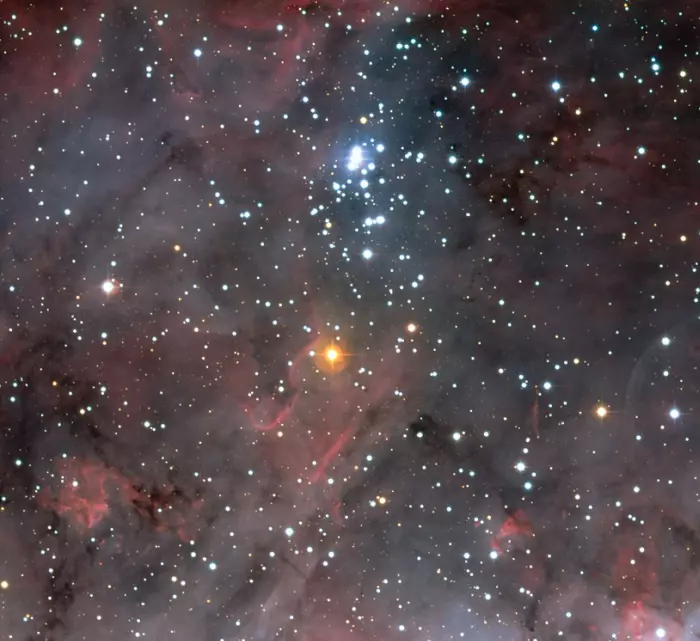
The Trumpler 15 open cluster on the north edge of the Carina Nebula. Image credit: ESO (CC BY 4.0)
Trumpler 16
Trumpler 16 (Tr 16) is the open cluster that contains Eta Carinae and WR 25. It is 9,270 light-years away and has an apparent magnitude of 5.0. Eta Carinae is the only member of the cluster that can be seen without binoculars. The cluster is also known as Collinder 234.
The most luminous members of the cluster – the binary systems Eta Carinae and WR 25 – are both several million times more luminous than the Sun. The cluster also hosts three exceptionally luminous main sequence stars of the spectral type O3.
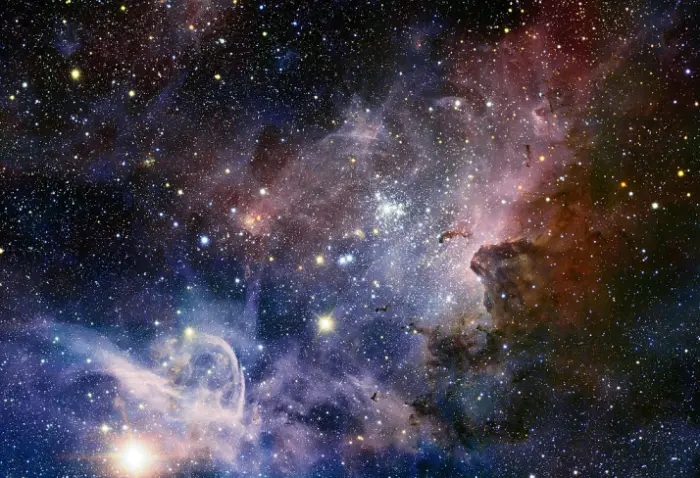
Trumpler 14 (centre) and Trumpler 16 with Eta Carinae (bottom left), image credit: ESO/T. Preibisch (CC BY 4.0)
Collinder 228
Collinder 228 is an open cluster about 10,000 light-years away. It appears in the southern part of the Carina Nebula.
The cluster has an apparent magnitude of 4.4 and an apparent size of 14 arcminutes. The brightest member, the variable star QZ Carinae, shines at magnitude 6.16 – 6.49, and is on the border of unaided eye visibility.
The star is in fact a multiple star system composed of four massive, luminous O- and B-type stars. The primary component is a blue supergiant of the spectral type O9.7I about 69.8 times more massive than the Sun and 400,000 times more luminous.
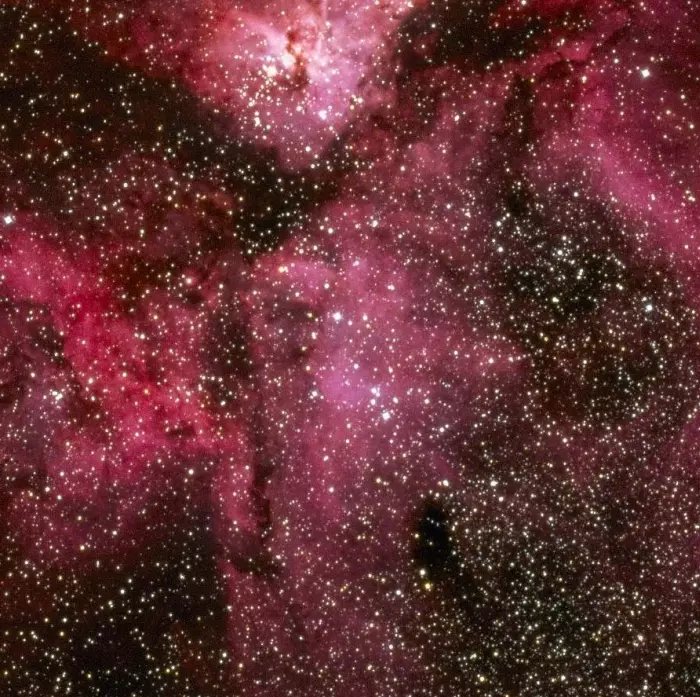
The image in this page was cropped from an image of great NGC 3372 which was obtained with the 0.6/0.9-meter Curtis/Schmidt Telescope of the Cerro Tololo Interamerican Observatory situated in Chile and operated by NOAO, in 1975. Image credit: Cerro Tololo Interamerican Observatory -CTIO (CC BY 4.0)
NGC 3324
NGC 3324 is a young open cluster located approximately 9,100 light-years away. It appears northwest of the Carina Nebula. The cluster and the nearby nebula IC 2599 (Gum 31) are sometimes known as the Gabriela Mistral Nebula, in reference to the Chilean poet. The two are closely related. NGC 3324 is also associated with the open cluster NGC 3293.
NGC 3324 has a radius of 15 light-years and a mass of 580 Suns. It occupies an area of 11 arcminutes of the apparent sky. The estimated age of the cluster is 12 million years.
The young cluster was first catalogued by Scottish astronomer James Dunlop in 1826. The cluster is also known as Collinder 225. A western section of the star forming region was imaged both by the Hubble Space Telescope (HST) and the James Webb Space Telescope (JWST). The section has been nicknamed Cosmic Cliffs.
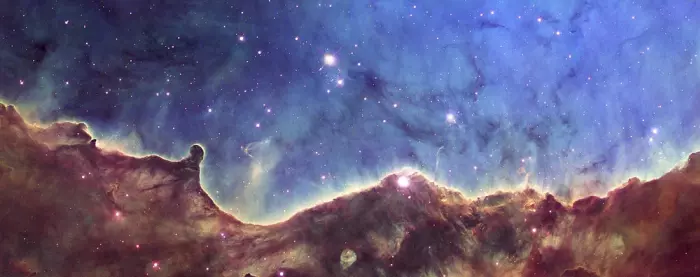
This three-dimensional-looking Hubble image shows the edge of the giant gaseous cavity within the star-forming region called NGC 3324. The glowing nebula has been carved out by intense ultraviolet radiation and stellar winds from several hot, young stars. A cluster of exceptionally massive stars, located well outside this image in the center of the nebula, is responsible for the ionization of the nebula and excavation of the cavity.
The image also reveals dramatic dark towers of cool gas and dust that rise above the glowing wall of gas. The dense gas at the top resists the blistering ultraviolet radiation from the central stars, and creates a tower that points in the direction of the energy flow. The high-energy radiation blazing out from the hot, young stars in NGC 3324 is sculpting the wall of the nebula by slowly eroding it away. This image is a composite of data taken with two of Hubble’s science instruments. Data taken with the Advanced Camera for Surveys (ACS) in 2006 isolated light emitted by hydrogen. Data taken in 2008 with the Wide Field Planetary Camera 2 (WFPC2) isolated light emitted by sulfur and oxygen gas. To create a color composite, the data from the sulfur filter are represented by red, from the oxygen filter by blue, and from the hydrogen filter by green. Image credit: NASA, ESA, and The Hubble Heritage Team (STScI/AURA)
NGC 3293
NGC 3293 is an open cluster located approximately 8,400 light-years away. It shines at magnitude 4.7 and has an apparent size of 8.2 arcminutes. It has a physical radius of 13.2 light-years and a mass of 1,457 solar masses. More than 100 stars in the cluster are brighter than 14th magnitude.
NGC 3293 is believed to be the same age as NGC 3324, about 12 million years old. The cluster is also catalogued as Collinder 224. It was discovered by the French astronomer Nicolas-Louis de Lacaille in 1751.
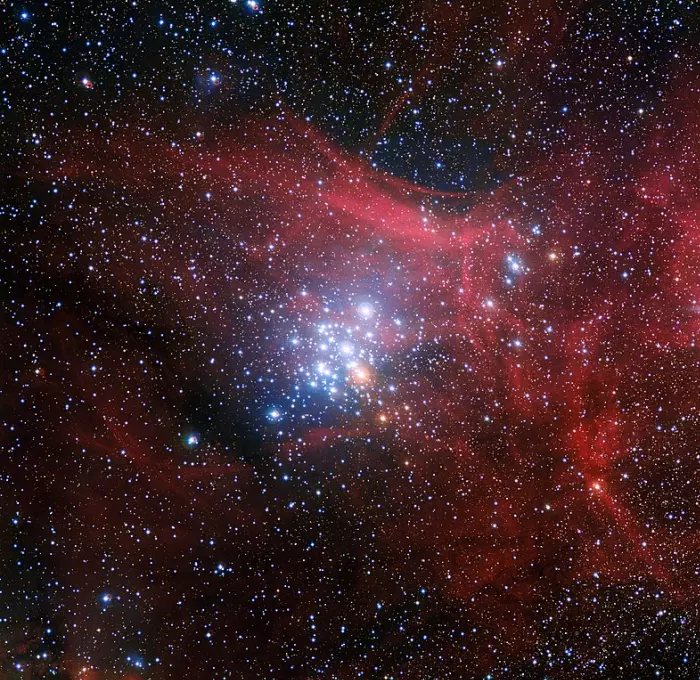
In this image from the Wide Field Imager on the MPG/ESO 2.2-metre telescope at ESO’s La Silla Observatory in Chile young stars huddle together against a backdrop of clouds of glowing gas and lanes of dust. The star cluster, known as NGC 3293, would have been just a cloud of gas and dust itself about ten million years ago, but as stars began to form it became the bright group we see here. Clusters like this are celestial laboratories that allow astronomers to learn more about how stars evolve. Image credit: ESO/G. Beccari (CC BY 4.0)
Carina Nebula – NGC 3372
| Constellation | Carina |
| Right ascension | 10h 45m 08.5s |
| Declination | −59° 52′ 04″ |
| Apparent magnitude | +1.0 |
| Apparent size | 120 × 120 arcminutes |
| Distance | ~8,500 llight-years (~2,600 parsecs) |
| Radius | 230 light-years (70 parsecs) |
| Names and designations | Carina Nebula, Eta Carinae Nebula, Great Carina Nebula, Grand Nebula, NGC 3372, Caldwell 92, GC 2197, ESO 128-EN013, h 3295, Gum 33, RCW 53, MHR 11, BRAN 316A, MSH 10-5-07 |
Images
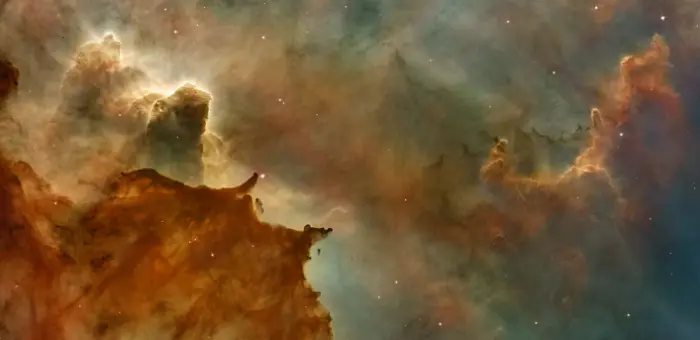
These great clouds of cold hydrogen resemble summer afternoon thunderheads. They tower above the surface of a molecular cloud on the edge of the nebula. So-called “elephant trunk” pillars resist being heated and eaten away by blistering ultraviolet radiation from the nebula’s brightest stars. Image credit: NASA, ESA, N. Smith (University of California, Berkeley), and The Hubble Heritage Team (STScI/AURA); credit for CTIO Image: N. Smith (University of California, Berkeley) and NOAO/AURA/NSF
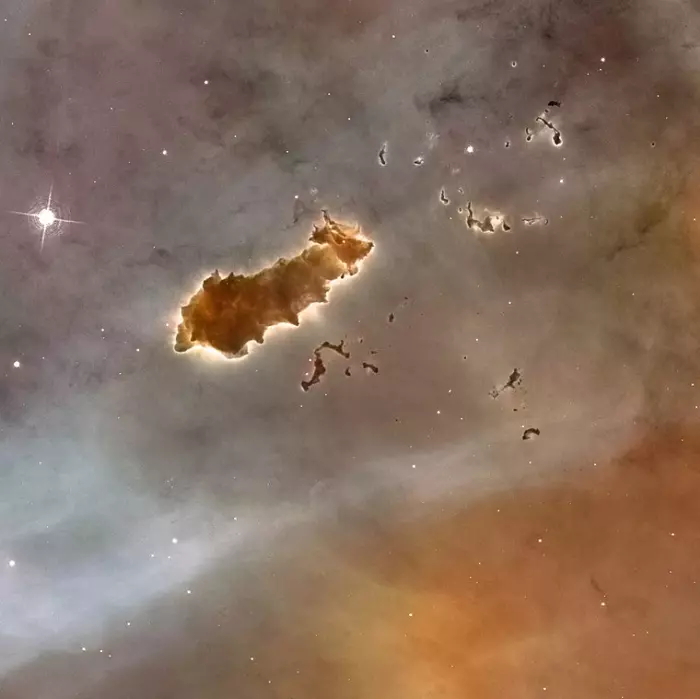
A Bok globule nicknamed the “caterpillar” appears at the right. Its glowing edge indicates that it is being photoionized by the hottest stars in the cluster. It has been hypothesized that stars may form inside such dusty cocoons. The top of the Keyhole Nebula, the most prominent feature embedded inside Carina, is on the left. Another Bok globule is in the foreground. Image credit – Hubble: NASA, ESA, N. Smith (University of California, Berkeley), and The Hubble Heritage Team (STScI/AURA); CTIO: N. Smith (University of California, Berkeley) and NOAO/AURA/NSF
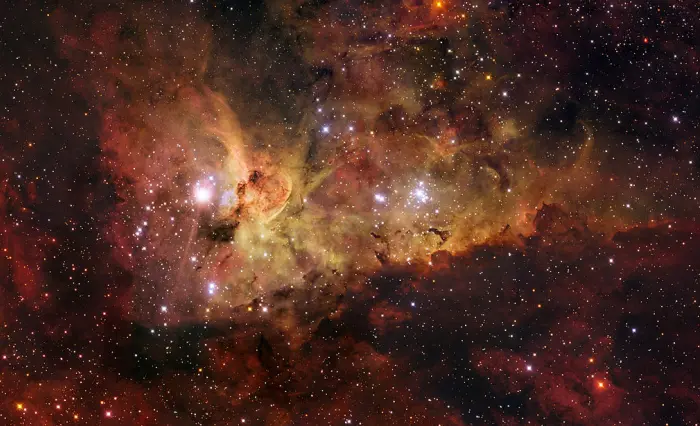
Carina Nebula mosaic based on images collected with the 1.5-m Danish telescope at ESO’s La Silla Observatory., image credit: ESO/IDA/Danish 1.5 m/R.Gendler, J-E. Ovaldsen, C. Thöne, and C. Feron (CC BY 4.0)
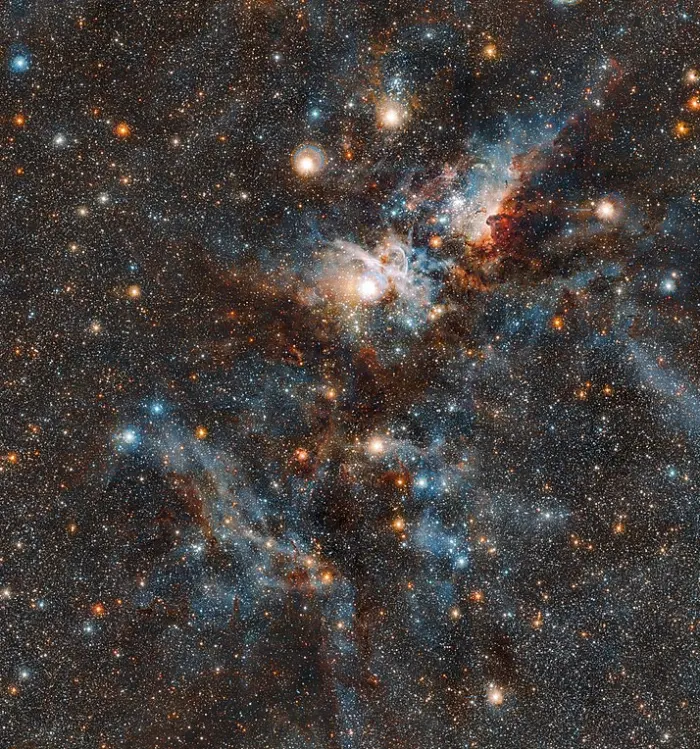
This spectacular image of the Carina Nebula in infrared light reveals the dynamic cloud of interstellar matter and thinly spread gas and dust as never before. The massive stars in the interior of this cosmic bubble emit intense radiation that causes the surrounding gas to glow. By contrast, other regions of the nebula contain dark pillars of dust cloaking newborn stars. Image credit: ESO/J. Emerson/M. Irwin/J. Lewis
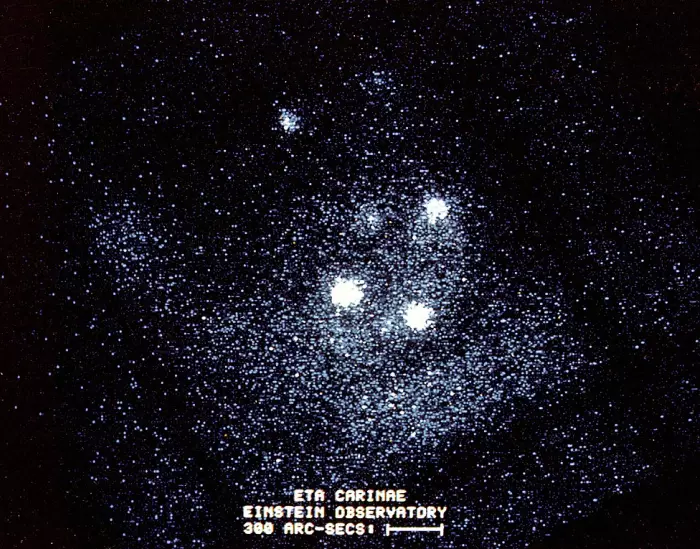
This image is an x-ray view of Eta Carinae Nebula showing bright stars taken with the High Energy Astronomy Observatory (HEAO)-2/Einstein Observatory. Image credit: NASA (1979)
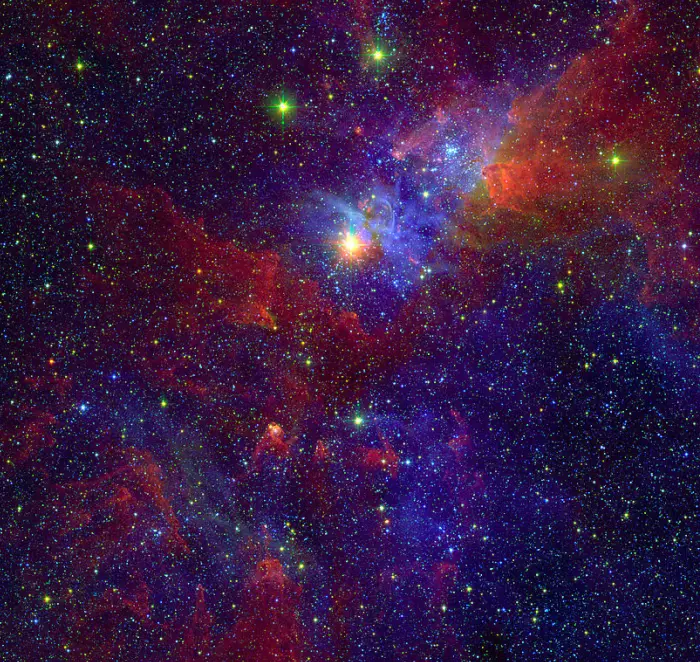
Eta Carinae is one of the most massive and brightest stars in the Milky Way. Compared to our own Sun, it is about 100 times as massive and a million times as bright. This famed variable hypergiant star (upper center) is surrounded by the Carina Nebula. In this composite image spanning the visible and infrared parts of the spectrum, areas that appear blue are not obscured by dust, while areas that appear red are hidden behind dark clouds of dust in visible light. A study combining X-ray and Infrared observations has revealed a new population of massive stars lurking in regions of the nebula that are highly obscured by dust. Adding these new massive stars to the known massive stars suggests that the Carina Nebula will produce twice as many supernova events as previously supposed. Visible light in the blue part of the spectrum from the Digital Sky Survey is represented as blue, near infrared light with a wavelength of 2.2 microns from the Two Micron All Sky Survey (2MASS) is green, and infrared observations from the Infrared Array Camera on NASA’s Spitzer Space telescope at 3.6 microns is red. Image credit: NASA/JPL-Caltech/M. Povich (Penn State Univ.)
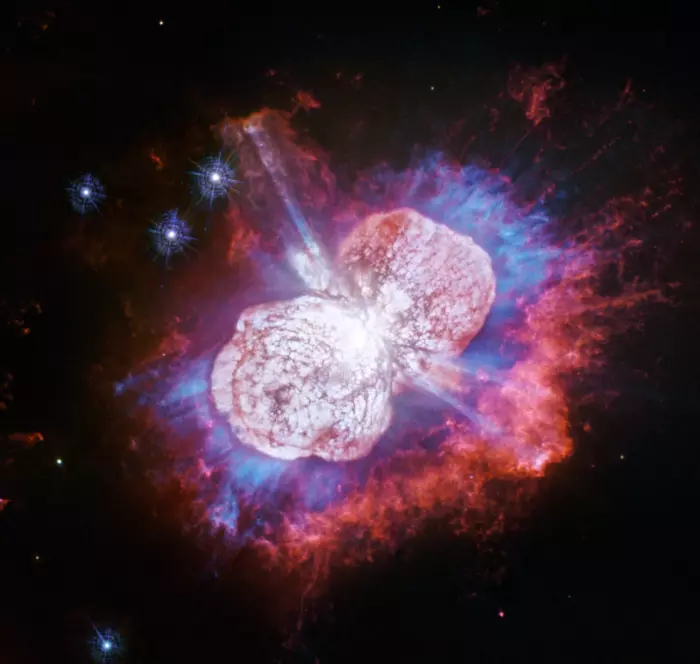
A new view from NASA’s Hubble Space Telescope, which includes ultraviolet light, shows the star’s hot, expanding gases glowing in red, white and blue. The stellar behemoth will eventually reach its finale when it goes out as a supernova. Using Hubble’s Wide Field Camera 3 to map the ultraviolet-light glow of magnesium embedded in warm gas (shown in blue), astronomers were surprised to discover the gas in places they had not seen it before. The team had expected to find light from magnesium coming from the same complicated array of filaments as seen in the glowing nitrogen (shown in red). Their unanticipated findings could reveal more about how the eruption began as well as shine light on studying other stars and gaseous nebulas. Image credit: NASA, ESA, N. Smith (University of Arizona) and J. Morse (BoldlyGo Institute) – (CC BY 2.0)